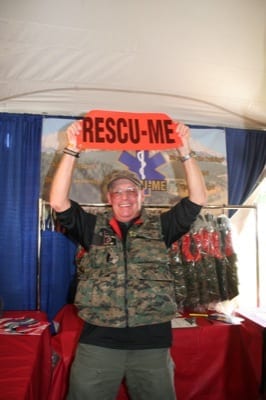If you had an unscheduled off-airport landing in rough back country, would you be able to survive to tell the story? Maybe, maybe not. It all comes down to how well prepared you are. A big part of that is having a survival kit, but if you can’t reach it after the “landing,” it doesn’t do a bit of good.
“Most of the crash sites I have been to, the tail of the airplane is about 400 feet behind the cockpit and when the survival kit is away from the main crash site, it doesn’t do anyone any good,” said Jim Herbert, who has more than 40 years experience as a pilot and back country guide and firefighter.
He’s also the creator of the Aviator Tactical Vest, which is designed for a 72-hour stay in the roughest terrain. Herbert began the vest design while he was embedded with a Hotshot Firefighting Crew in the back country of Idaho.
 “Haven’t survival vests been around for years?” I asked when I caught up with Herbert at the Arlington Fly-in and Sport Aviation Convention in July.
“Haven’t survival vests been around for years?” I asked when I caught up with Herbert at the Arlington Fly-in and Sport Aviation Convention in July.
“Not like this,” said Herbert, displaying a formidable looking vest laden with pockets of all sizes.“The Rescu-Me vest is a stand alone survival vest. It is designed for pilots, as well as hunters, the military, the fish and game officer, tactical workers, and so forth.”
The vests are made of 1000 Denier Cordura, a very heavy weight nylon with a urethane coating, that comes in either black or a woodland camouflage design that reverses to high visibility orange.
Protection from the elements is key in a survival situation, said Herbert, noting that hypothermia is a very real danger.
“The vests have a patented layer of reflective fabric between the two layers. This layer of patented fabric is not only reflective of light but, more importantly, reflective of heat,” he said. “It has the ability to reflect the summer’s heat away from you or keep your body heat inside during the winter. This fabric has a tested 92% reflectability rate for thermal energy and completely blocks electromagnetic radiation while being very lightweight and permeable to water vapor and sweat.”
In addition, the vests have a hood stowed in the collar that can easily be deployed to minimize body heat loss through the head.
One of the vest’s key features is what Herbert calls the “prioritized pockets” in which equipment necessary for survival are included and arranged in the order of usefulness.
“The upper left pocket has room for a navigation compass, flash gear and a small first aid kit. The right hand pocket is a little larger and it can hold a Personal Locator Beacon, a radio, and a fixed bladed knife. I offer two choices. My favorite is the Swedish blade called the Light My Fire because it has a magnesium fire starter in the handle.”
Each vest also comes with a high visibility RESCU ME panel that can be used to signal search & rescue aircraft.
The vest also includes a shelter blanket, a micro-fiber blanket designed to wick moisture away from the body, and 50 feet of military spec chord. Food, in the form of a 3,600-calorie food bar, sits in a pocket opposite a water purification filter, water purification tablets, and heavy duty ziplock bags.
The vests are easy to restock with off-the-shelf items, Herbert added. Fully loaded vests weigh about 11 pounds.
For the pilot who doesn’t want to wear the vest in the airplane, Herbert has an egress pack designed to drape over the seat.
“It’s a ballistic nylon pouch that can be removed with one tug of a quick-release rip-chord,” said Herbert. “Because it’s on the back of the seat it doesn’t get in the way during an emergency evacuation of the airplane. You get out of the airplane, pull the chord and go.”
The basic vest sells for $260. The fully loaded vest is $440.
For more information: Rescu-me.com
